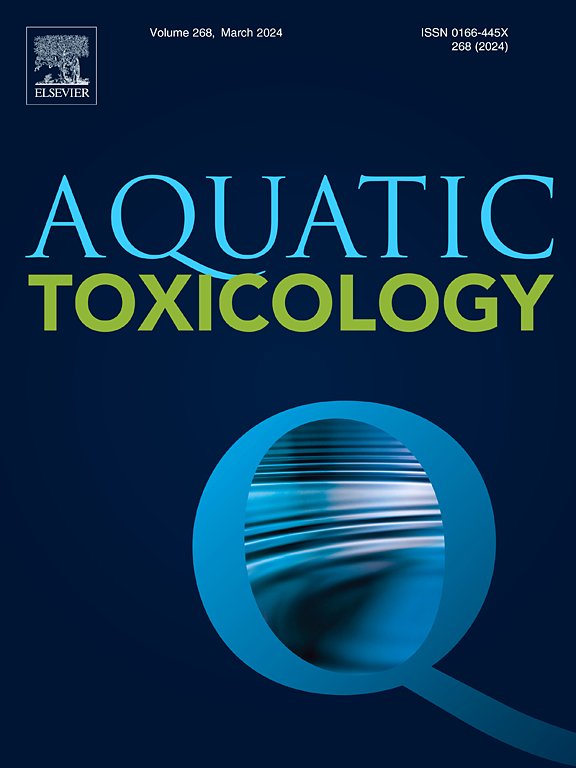Polar cod early life stage exposure to potential oil spills in the Arctic
IF 4.1
2区 环境科学与生态学
Q1 MARINE & FRESHWATER BIOLOGY
引用次数: 0
Abstract
Arctic amplification of climate change is causing sea ice to retreat at unprecedented rates, potentially opening up large vulnerable Arctic areas for oil and gas exploration and new shipping routes. This rapid warming marginalizes sympagic species habitats making them more sensitive to other anthropogenic pressures. Here, we assess potential impacts of hypothetic oil spills from the northernmost licensed oil field Wisting and additional neighbouring spill sites in areas currently not open to oil exploitation on the key ice-associated Arctic fish species polar cod (Boreogadus saida). We do this by developing and running combined data-driven models for the ocean, oil spill dispersal and fate, and the early life stages of polar cod. Sea ice and the Polar Front act as natural barriers limiting the exchange of polar cod eggs and larvae and oil spill between Atlantic and Polar Water. However, both barriers vary seasonally so that the sea ice retreats and the Polar Front weakens towards summer causing significant increases in oil exposure to early life stages of polar cod under varying oil spill scenarios investigated here. Previous literature emphasizes that fall feeding conditions must be sufficient for juvenile polar cod to allocate lipids and survive their first winter. Here, we show that less than half the exposed individuals experience these suitable feeding conditions in the fall. The seasonal exposure intensity suggests a need for petroleum regulations with temporal and spatial limitations varying through the year. However, even with these seasonal dynamic regulations in place, climate change induced by the use of fossil fuel will likely reduce these natural barriers through continued sea ice retreat and a weakening of the Polar Front thereby reducing their barrier effects. Risk assessments of anthropogenic impacts on key Arctic ecosystem components in the vicinity of the ice edge zone and the Polar Front will therefore have to be updated to account for these major changes.
气候变化的北极放大效应正导致海冰以前所未有的速度消退,有可能为石油和天然气勘探以及新航道开辟大片脆弱的北极地区。这种快速变暖使交配物种的栖息地边缘化,使它们对其他人为压力更加敏感。在这里,我们评估了最北端获得许可的油田 Wisting 和目前尚未开放石油开采地区的其他邻近溢油点的假定溢油对与冰相关的关键北极鱼类北极鳕鱼(Boreogadus saida)的潜在影响。为此,我们针对海洋、溢油扩散和最终结果以及极地鳕鱼的早期生命阶段开发并运行了数据驱动型综合模型。海冰和极地前线是限制极地鳕鱼卵和幼体以及大西洋和极地水域之间溢油交换的天然屏障。然而,这两道屏障会随季节变化,因此在夏季,海冰会后退,极地前线会减弱,从而导致在本文调查的不同溢油情况下,极地鳕鱼早期生命阶段的油暴露量显著增加。以前的文献强调,秋季的觅食条件必须足以让幼年极地鳕鱼分配脂质并度过第一个冬季。在这里,我们发现只有不到一半的暴露个体在秋季经历了这种合适的觅食条件。季节性暴露强度表明,有必要制定石油法规,对时间和空间的限制在一年中有所不同。然而,即使制定了这些季节性动态法规,化石燃料的使用引起的气候变化也可能会通过持续的海冰消退和极地前线的减弱来减少这些天然屏障,从而降低其屏障效应。因此,必须更新对冰缘区和极地前线附近北极关键生态系统组成部分人为影响的风险评估,以考虑到这些重大变化。
本文章由计算机程序翻译,如有差异,请以英文原文为准。
求助全文
约1分钟内获得全文
求助全文
来源期刊

Aquatic Toxicology
环境科学-毒理学
CiteScore
7.10
自引率
4.40%
发文量
250
审稿时长
56 days
期刊介绍:
Aquatic Toxicology publishes significant contributions that increase the understanding of the impact of harmful substances (including natural and synthetic chemicals) on aquatic organisms and ecosystems.
Aquatic Toxicology considers both laboratory and field studies with a focus on marine/ freshwater environments. We strive to attract high quality original scientific papers, critical reviews and expert opinion papers in the following areas: Effects of harmful substances on molecular, cellular, sub-organismal, organismal, population, community, and ecosystem level; Toxic Mechanisms; Genetic disturbances, transgenerational effects, behavioral and adaptive responses; Impacts of harmful substances on structure, function of and services provided by aquatic ecosystems; Mixture toxicity assessment; Statistical approaches to predict exposure to and hazards of contaminants
The journal also considers manuscripts in other areas, such as the development of innovative concepts, approaches, and methodologies, which promote the wider application of toxicological datasets to the protection of aquatic environments and inform ecological risk assessments and decision making by relevant authorities.
 求助内容:
求助内容: 应助结果提醒方式:
应助结果提醒方式:


